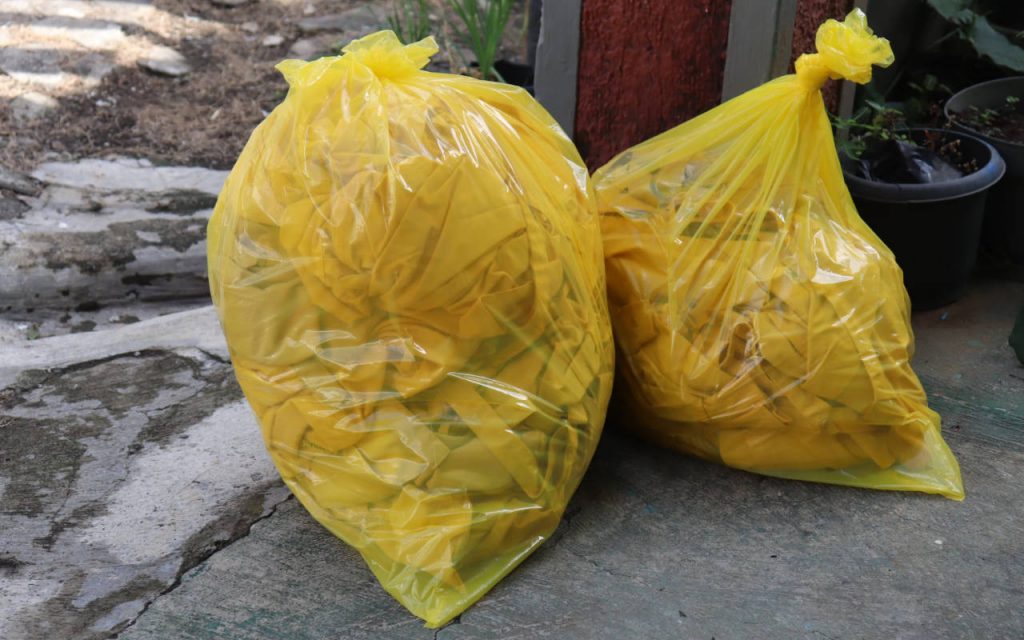While the alternatives for plastic packaging are numerous and visible, the alternatives for waste management are a bit obscure by comparison. What other material is as strong, protective and leak resistant as polythene?
Paper bags are infamously weak when wet. Glass has no flexibility, poses further dangers when shattered, and has a major weight penalty. And biodegradable, or so-called “eco” plastics have proven to be anything but environmentally-friendly.
That leaves two options; using the ever-dependable polythene bag (with recycled content, of course), or going bagless. But that’s only an option for domestic waste, and not a very pleasant one at that.
Dangerous waste poses a real threat of harm to people, animals, and the environment. Even the very stinkiest bin you’ve ever had to empty is absolutely nothing compared to hospital waste or asbestos. Hazardous waste is truly nasty stuff, even in its tamest form.
And so, hazardous waste needs serious solutions. Polythene hazardous waste bags are non-negotiable for disposing of anything that could cause harm, infection, disease, or poisoning.
But not all hazardous waste bags are the same; different colours can mean different things, and protocols can vary between dangerous waste types – like double-bagging, minimum gauge thicknesses, and so on.
Let’s take a closer look at hazardous waste bags and how they should be used.

Hazardous waste bag colours and meanings
These are the different colour codes for hazardous waste used for medical waste, which is the most common use for hazardous waste bags. Bags are often used in conjunction with bins, or omitted if the primary use is sharps (things like needles and surgical blades) which would poke through the bag easily.
| Colour | Waste type | Usage recommendations |
| Yellow | Clinical, highly infectious | Yellow hazardous waste bags are used for any materials (like gloves, PPE, or syringes) contaminated with infectious bodily fluids. Sealed bins are used for sharps. All yellow stream waste is sent for incineration. |
| Orange | Clinical, infectious | All materials (including PPE) used for patients suspected to be infectious must be disposed of in the orange hazardous waste disposal stream. Bags can be printed with usage details. |
| Tiger (yellow and black) | Offensive, non-infectious | Offensive waste includes colostomy bags, nappies, incontinence pads, and disposable PPE that have not come into contact with infectious body fluids. Tiger-coloured waste bags are commonly a yellow base, printed with black stripes. |
| Red | Anatomical | Any waste arising from surgical procedures (body parts, blood bags and organs) is placed in the red waste stream, for incineration. |
| Blue | Medicinal | Blue waste bins are used for non-toxic medicines that have expired and need to be disposed of. All blue waste is incinerated. |
| Purple | Cytotoxic and Cytostatic | Cytotoxic and cytostatic waste is anything contaminated by cancer treatment and chemotherapy drugs. This includes needles and syringes used to administer chemo treatments. |
| Clear | Lateral flow tests | This is a relatively new waste stream, used for the disposal of Covid-19 testing materials. Clear bags can also be printed, if required. |
| White | Dental, toxic | White waste is used for toxic and non-toxic dental waste, like gypsum and amalgam. Amalgam is used in tooth fillings, and while considered safe for human use, contains mercury – a poisonous metal that needs careful disposal. |
Learn more about:
Asbestos bags
We’ve also covered polythene bags for asbestos disposal, another common hazardous waste type that has strict disposal requirements.
All asbestos waste must be double-wrapped and labelled, using a red coloured polythene inner bag, printed with asbestos warnings, and a clear polythene outer bag, with the carriage of dangerous goods (CDG) hazard sign printed onto it.
Yellow hazardous waste bags for other materials
Yellow hazardous waste bags, printed with warning labels, are a generic solution for all types of hazardous waste outside of a hospital setting. They are made of heavy duty polythene, and sealed with cable ties for security.
Yellow waste bags are incinerated and do not go to landfill.
Yellow hazardous waste bags can be used for the rags and wipes used in the cleanup of most chemical and oil spillages, as one example – but can also store many other types of dangerous waste. LDPE bags are highly resistant to corrosion from strong solvents, and even some acids and bases, as this chart shows.
For ease of identification from other types of hazardous waste, blue bags can also be used.
Strength: using bottom gusseted bags
Hazardous waste bags are typically bottom gusseted bags, which afford additional strength and capacity. That’s important when the material they contain is likely to cause significant harm in the event of a leak.
It’s also important to use heavy duty polythene where appropriate, to prevent notching, leaking and lower the risk of contamination. Proper sealing must be considered when dealing with hazardous waste, and all disposal should be carried out in accordance with government guidelines.
Coloured polythene bags for hazardous waste
Order coloured hazardous waste bags from NPF Packaging – the polythene packaging experts. Get a quote now, or call us on 01773 820415 to get started.


